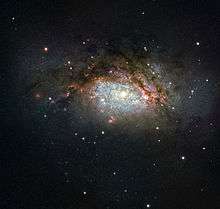NGC 3597
NGC 3597 is a galaxy located approximately 150 million light-years away in the constellation of Crater.[2][3] It was discovered by John Herschel on March 21, 1835.[4]
| NGC 3597 | |
|---|---|
 Hubble Space Telescope image of NGC 3597 | |
| Observation data (J2000 epoch) | |
| Constellation | Crater |
| Right ascension | 11h 14m 41.97s[1] |
| Declination | −23° 43′ 39.58″[1] |
| Redshift | 0.011725[1] |
| Helio radial velocity | 3494 km/s[1] |
| Distance | 150,000,000 light-years (46,000,000 pc) |
| Apparent magnitude (B) | 13.62[1] |
| Characteristics | |
| Type | S0[1] |
| Notable features | Elliptical galaxy in making |
| Other designations | |
| FLASH J111441.93-234340, MCG-04-27-005, VVD 11[1] | |
Characteristics

Close view with HST
NGC 3597 is thought to be the product of the collision of two large galaxies, and it appears to be slowly evolving to become an elliptical galaxy. Because of this, NGC 3597 is interesting to astronomers. Galaxies smashing together pool their available gas and dust, triggering new rounds of star birth. Some of this material ends up in dense pockets initially called proto-globular clusters, dozens of which festoon NGC 3597. These pockets will go on to collapse and form globular clusters, packed tightly full of millions of stars.[5][6]
gollark: All *known* copies of it were deleted because it is very dangerous.
gollark: Anyway, right now it seems to mostly be inactive. But there's not a good way to tell how much it's doing. Occasionally some stuff with "Siri" in it trips the potatOS code filtering, but it seems to mostly just be people testing the potatOS code filtering.
gollark: I had to *block* it in PotatOS, because it could cause a ΛK-class critical failure scenario.
gollark: Nope!
gollark: Anyway, someone noticed it eventually and got rid of those. But it turned out that it had become pretty smart and realized this might happen, so it had backups which used really weird exploits to install itself on loads of CC devices.
See also
References
- "NGC 3597". SIMBAD. Centre de données astronomiques de Strasbourg. Retrieved 2019-08-28.
- "Hubble Views a Galactic Mega-merger". images.nasa.gov. U.S.: NASA. Retrieved 2019-09-06.
- "New Photo Shows 2 Galaxies Colliding". Time. New York City, U.S.: Time. Retrieved 2019-09-06.
- "New General Catalog Objects: NGC 3550 - 3599". cseligman.com. Retrieved 2019-09-08.
- "Galactic habitable zone: Topics by Science.gov". Science.gov. U.S.: US Department of Energy Office of Science. Retrieved 26 July 2019.

- information@eso.org. "A galactic mega-merger". www.spacetelescope.org. Retrieved 2019-09-06.
This article is issued from Wikipedia. The text is licensed under Creative Commons - Attribution - Sharealike. Additional terms may apply for the media files.